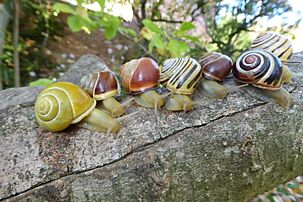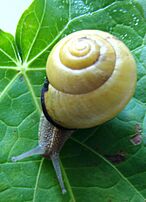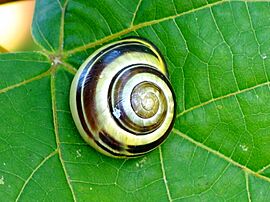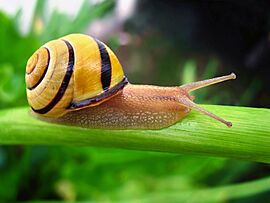Lemon or Grove snail facts for kids
Quick facts for kids Lemon or Grove SnailCepaea nemoralis |
|
|---|---|
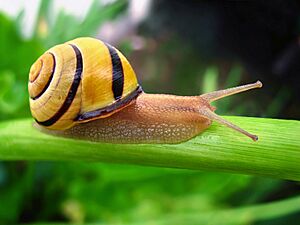 |
|
| Cepaea nemoralis | |
| Conservation status | |
| Scientific classification | |
| Synonyms | |
|
The grove snail, also known as the brown-lipped snail or lemon snail (Cepaea nemoralis), is a type of air-breathing land snail. It's a mollusc that lives on land.
This snail is one of the most common large land snails found in Europe. It has also been brought to North America. Scientists often study Cepaea nemoralis to learn about how living things change over time and how they fit into their environment.
Contents
What Does It Look Like?
Cepaea nemoralis is one of the biggest and most colorful snails in Western Europe. Its shell can be many different colors, like brown, pink, yellow, or even almost white. Some shells have dark brown stripes, while others have none. There can be one to five stripes.
The edge of the shell opening on adult snails is usually dark brown and a bit thick. This is called the "lip." Young snails have a small opening in the center of their shell, but it closes up as they grow. The shell surface is a bit shiny. An adult snail's shell has about 4 to 5 turns, and it's usually 18–25 millimeters wide and 12–22 millimeters tall.
How to Tell It Apart from Other Snails
The grove snail is very similar to another snail called the Cepaea hortensis. They often live in the same places and have similar shell colors and stripe patterns.
Cepaea nemoralis usually grows a bit larger than C. hortensis. The easiest way to tell them apart is by looking at the color of the lip around the shell's opening. Most C. nemoralis snails have a dark brown lip, while C. hortensis snails usually have a white lip.
There are also other snails that look a bit like Cepaea nemoralis, but they have small differences. For example, some have a small bump inside their shell opening, or their stripes are placed differently.
Why Are Their Shells So Colorful?
Cepaea nemoralis shells come in many different colors and patterns. This is called being "polymorphic." The main color of the shell can be brown, pink, yellow, or even almost white. Some shells have dark stripes, and some don't. The stripes can be thick or thin, and there can be anywhere from zero to five of them.
Scientists have studied why these snails have so many different looks. Here are some ideas:
- Camouflage: In forests, darker shells might help snails hide better. In open, sunny places, lighter shells might help them stay cooler by reflecting sunlight.
- Climate: Yellow shells are more common in warmer, southern areas. This might be because lighter colors help snails avoid getting too hot.
- Predators: Birds like the song thrush eat these snails. If a bird gets used to finding one color of snail, the rarer colors might be safer. This helps keep many different colors and patterns around.
It's likely that a mix of these reasons helps explain why grove snails have such varied and beautiful shells.
- Different coloration and banding of the shells of Cepaea nemoralis
Where Do Grove Snails Live?
The grove snail naturally lives across Western and Northern Europe, and into Central Europe. In recent years, it has been spreading more towards Eastern Europe. You can find it in many countries, from Spain and France to Germany, the Netherlands, and parts of Scandinavia.
In places like Poland, Latvia, Estonia, and Ukraine, it has spread along the Baltic coast and other areas. In some northern parts of its range, like northern Scotland, it's less common and was likely brought there by people.
Since 1857, grove snails have also been brought to North America. They are now found widely in Canada, from British Columbia to Newfoundland. They also live in the northeastern United States and in some areas further south, like California and Texas. Sometimes, people have even moved these snails on purpose.
Life and Habits
This snail is very common in Western Europe. It lives in many different places, from sandy coastal areas to thick woodlands, gardens, and empty lots. In Eastern Europe, where it's newer, it often shows up in cities and disturbed areas. These snails can live at high altitudes, up to 1600 meters in the Alps. You might find about two adult snails in every square meter of ground.
Grove snails mostly eat dead or dying plants, especially broad-leaved plants rather than grasses. While they usually don't harm crops, they can sometimes be a problem in vineyards because they get picked along with the grapes.
Reproduction and Life Cycle
Like all land snails, the grove snail is a hermaphrodite, meaning each snail has both male and female parts. However, they still need to mate with another snail to produce fertile eggs. Mating usually happens in late spring and early summer, but it can continue into the autumn.
After mating, snails can store the sperm they receive for a while. A single group of eggs can even have fathers from different mates. In Britain, these snails lay clutches of 30–50 oval eggs between June and August. In France, they lay 40–80 eggs from May to November. The eggs are about 2.3–3.1 millimeters wide. Baby snails hatch from the eggs after about 15–20 days.
Grove snails grow slowly. It takes them 1 to 3 years to grow from an egg to an adult that can reproduce. They can live for up to seven or eight years. In winter, snails might hibernate (go into a deep sleep), but they can wake up if the weather gets warm.
One of the main predators of the grove snail is the song thrush, a type of bird.



